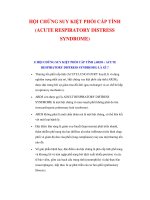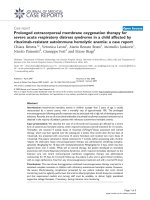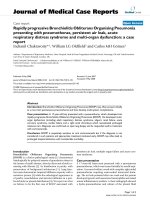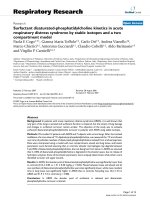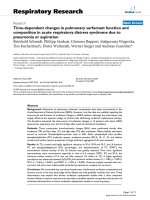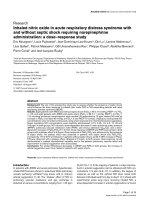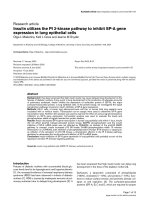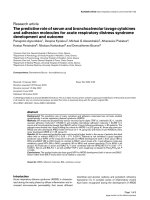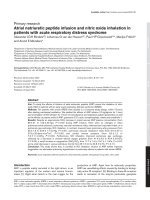Pulmonary and extrapulmonary acute respiratory distress syndrome are different
Bạn đang xem bản rút gọn của tài liệu. Xem và tải ngay bản đầy đủ của tài liệu tại đây (318.85 KB, 9 trang )
Copyright #ERS Journals Ltd 2003
European Respiratory Journal
ISSN 0904-1850
Eur Respir J 2003; 22: Suppl.42, 48s–56s
DOI: 10.1183/09031936.03.00420803
Printed in UK – all rights reserved
Pulmonary and extrapulmonary acute respiratory distress
syndrome are different
P. Pelosi*, D. D9Onofrio*, D. Chiumello#, S. Paolo*, G. Chiara*, V.L. Capelozzi}, C.S.V. Barbasz,
M. Chiaranda*, L. Gattinoni#
Pulmonary and extrapulmonary acute respiratory distress syndrome are different. P. Pelosi,
D. D9Onofrio, D. Chiumello, S. Paolo, G. Chiara, V.L. Capelozzi, C.S.V. Barbas,
M. Chiaranda, L. Gattinoni. #ERS Journals Ltd 2003.
ABSTRACT: Acute respiratory distress syndrome (ARDS) can be derived from two
pathogenetic pathways: a direct insult on lung cells (pulmonary ARDS (ARDSp)) or
indirectly (extrapulmonary ARDS (ARDSexp)). This review reports and discusses
differences in biochemical activation, histology, morphological aspects, respiratory
mechanics and response to different ventilatory strategies between ARDSp and
ARDSexp. In ARDSp the direct insult primarily affects the alveolar epithelium with a
local alveolar inflammatory response while in ARDSexp the indirect insult affects the
vascular endothelium by inflammatory mediators through the bloodstream.
Radiological pattern in ARDSp is characterised by a prevalent alveolar consolidation
while the ARDSexp by a prevalent ground-glass opacification. In ARDSp the lung
elastance, while in ARDSexp the chest wall and intra-abdominal chest elastance are
increased. The effects of positive end-expiratory pressure, recruitment manoeuvres and
prone position are clearly greater in ARDSexp.
Although these two types of acute respiratory distress syndrome have different
pathogenic pathways, morphological aspects, respiratory mechanics, and different
response to ventilatory strategies, at the present, is still not clear, if this distinction can
really ameliorate the outcome.
Eur Respir J 2003; 22: Suppl. 42, 48s–56s.
Since its initial description, the acute respiratory distress
syndrome (ARDS) has been considered as a morphological
and functional expression of a similar underlying lung injury
caused by a variety of insults. In fact, ASHBAUGH et al. [1] in
defining this syndrome stated that "The etiology of this
respiratory distress syndrome remains obscure. Despite a
variety of physical and possibly biochemical insults, the
response of the lung was similar in all 12 patients. In view of
the similar response of the lung to a variety of stimuli, a
common mechanism of injury may be postulated".
This observation used the term syndrome to refer to "a
group of symptoms and signs of disordered function related
to one another by means of some anatomic, physiologic, or
biochemical peculiarity" [2]. In 1994, the American-European
Consensus Conference defined two pathogenetic pathways
leading to ARDS: a direct ("primary" or "pulmonary") insult,
that directly affects lung parenchyma, and an indirect
("secondary" or "extrapulmonary") insult, that results from
an acute systemic inflammatory response [3]. The differentiation between direct and indirect insult is often straightforward as for primary diffuse pneumonia or ARDS
originating from intra-abdominal sepsis. In other situations,
the precise identification of the pathogenetic pathway is
somewhat questionable, as for trauma or cardiac surgery. The
distinction, however, was mainly speculative until GATTINONI
et al. [4] reported possible differences in the underlying
pathology, respiratory mechanics, and response to positive
end-expiratory pressure (PEEP) in pulmonary ARDS
(ARDSp, primarily pneumonia) and extrapulmonary ARDS
*Dept of Clinical and Biological Sciences,
University of Insubria, Varese-Circolo and
Fondazione Macchi Hospital, Varese, Italy.
#
Institute of Anesthesia and Critical Care,
University of Milano-Policlinico Hospital,
IRCCS, Milano, Italy. }Dept of Pathology
z
and Division of Respiratory Diseases, University of Sao Paulo, School of Medicine,
Sao Paulo, Brazil.
Correspondence: D. Chiumello, Institute of
Anesthesia and Critical Care, Ospedale Policlinico IRCCS, Via F. Sforza 20122, Milano,
Italy.
Fax: 39 0255033230
E-mail:
Keywords: Computed tomography, positive
end-expiratory pressure, prone position,
pulmonary and extrapulmonary acute respiratory distress syndrome, respiratory mechanics,
ventilator-induced lung injury
(ARDSexp, primarily due to abdominal disease). In table 1
are reported the underlying etiologies in ARDSp and
ARDSexp. Since then, the distinction between ARDSp
and ARDSexp has gained attention and an increasing
number of papers on this subject have appeared in the
scientific literature [5–8].
However, it is increasingly debated whether distinction
between ARDSp and ARDSexp is only anecdotic or can have
a clinical impact on therapeutic strategies [9–11].
This review, reports and discusses possible differences in
ARDS of different origins regarding: 1) epidemiology, 2)
pathophysiology, 3) morphological aspects, 4) respiratory
mechanics, 5) ventilatory strategies, 6) response to pharmacological agents and 7) long-term recovery.
Table 1. – Underlying etiologies of pulmonary and extrapulmonary acute respiratory distress syndrome
ARDSp
ARDSexp
Bacterial, fungal, viral
parasitic pneumonia
Aspiration of gastric content
Pulmonary contusion
Inhalation injury
Fat emboli
Sepsis
Trauma
Drug overdose
Acute pancreatitis
Cardiopulmonary bypass
ARDSp: pulmonary acute respiratory distress syndrome; ARDSexp:
extrapulmonary acute respiratory distress syndrome.
49s
PULMONARY AND EXTRAPULMONARY ARDS
Epidemiology
ARDS occurs following a variety of risk factors [12]. A
strong evidence that supports a cause-and-effect relationship
between ARDS and risk factors was identified for sepsis,
trauma, multiple transfusions, aspiration of gastric contents,
pulmonary contusion, pneumonia, and smoke inhalation.
However, only a few studies have investigated the prevalence
and mortality considering ARDSp and ARDSexp. In the
majority of available studies the prevalence of ARDSp was
higher compared to ARDSexp, varying from 47 to 75% of all
cases [4–6, 13–15]. In the most recent retrospective analysis of
patients enrolled in the Acute Respiratory Distress Syndrome
Network (ARDSNet) trial of low tidal volume ventilation,
roughly an equal proportion of ARDSp and ARDSexp was
identified [16]. It has been reported that pulmonary trauma
was associated with higher survival rate, whereas opportunistic pneumonia had a lower survival rate [17, 18]. Among
complications, acute renal failure, pulmonary infection, and
bacteraemia seem to be independent factors associated with
increased mortality [19]. However, the reported mortality in
patients with ARDS attributable to pulmonary and extrapulmonary causes varies considerably. In one study a direct
pulmonary insult triggering ARDS was identified as being
associated with increased mortality [20], whereas in another
study no relationship was found between direct pulmonary
insults and increased mortality (36% and 34% mortality for
pulmonary and extrapulmonary causes, respectively) [16].
Moreover, in the same cohort of patients, the proportion of
patients in whom organ failure developed, the pulmonary and
extrapulmonary were equal between groups, and the proportion achieving liberation from mechanical ventilation at 28
days was also identical. The lack of agreement among various
studies can be explained by differences in: 1) baseline status;
2) the prevalence of the disease precipitating ARDS in each
centre; 3) the impact of therapy; and 4) the overall distribution of these factors in the studied population. Thus, it
is not known whether different clinical management and
ventilatory treatment modified accordingly with the different
pathophysiological characteristics could improve outcome. In
the current authors9 opinion, the distinction between ARDSp
and ARDSexp should not be focused, at the moment, on
possible differences in morbidity and mortality. It is more
important first to understand if this distinction is truly large
and carries major implications for clinical management. If it
does, further studies on morbidity and mortality would be
reasonable once differences in clinical strategy were clarified.
Table 2. – Histological and biochemical alterations in
pulmonary and extrapulmonary acute respiratory distress
syndrome
ARDSp
Alveoli
Alveolar epithelium
Alterated type I and II cell
Alveolar neutrophils
Apoptotic neutrophils
Fibrinous exudates
Alveolar collapse
Local interleukin
Interstitial space
Interstitial oedema
Collagen fibres
Elastic fibres
Capillary endothelium
Blood
Interleukin
TNF-a
ARDSexp
qqDamage
qqDamage
Prevalent
Prevalent
Present
qqIncreased
Prevalent
Damage
Normal
Rare
Rare
Rare
Increased
Rare
Absent
qqIncreased
Normal
Normal
High
Increased
Normal
qqDamage
Increased
Increased
qqIncreased
qqIncreased
ARDSp: pulmonary acute respiratory distress syndrome; ARDSexp:
extrapulmonary acute respiratory distress syndrome.
The alveolar-capillary barrier is formed by two different
structures, the alveolar epithelium and the vascular endothelium. Traditionally, it has been though that insults applied to
the lung, through the airways or the circulation, result in
diffuse alveolar damage. Although many insults may converge in the stage of ARDS, the present authors wonder if, in
early stages, a direct or indirect insult to the lung may have
different manifestations [21]. The different histological and
biochemical alterations in ARDSp and ARDSexp are
reported in table 2.
[23], tumour necrosis factor (TNF) [24], or bacteria [25]. After
a direct insult, the primary structure injured is the alveolar
epithelium, while the capillary endothelium is roughly normal
[26]. This causes activation of alveolar macrophages and
neutrophils and of the inflammatory network, leading to
intrapulmonary inflammation. An increased amount of
apoptotic neutrophils and alterated type I and type II cells
has been reported as well as an increase in interleukins (IL)-6,
8 and 10 in the bronchoalveolar lavage (BAL) in direct injury
compared to indirect injury [26]. The prevalence of the
epithelial damage determines a localisation of the pathological abnormality in the intra-alveolar space, with alveolar
filling by oedema, fibrinous exudate, collagen, neutrophilic
aggregates, and/or blood, with a minimum interstitial oedema.
This pattern has often been described as pulmonary consolidation, probably representing a combination of alveolar
collapse and prevalent fibrinuous exudates and alveolar wall
oedema in ARDSp.
An indirect insult has been studied in experimental models
by intravenous [27] or intraperitoneal [28] toxic injection.
After an indirect insult, the lung injury originates from the
action of inflammatory mediators released from extrapulmonary foci into the systemic circulation. In this case, the first
target of damage is the pulmonary vascular endothelium, with
an increase of vascular permeability and interstitial oedema.
A decreased amount of apoptotic cells has been described in
experimental model of ARDSexp as well as a decreased
amount of ILs in the BAL [26]. Thus, the pathological
alteration due to an indirect insult is primarily microvascular
congestion and interstitial oedema, with relative sparing of
the intra-alveolar spaces. Recently ROCCO et al. [29]
investigated the effect of corticosteroids in the ARDSp and
ARDSexp. They found that steroids inhibited extracellular
matrix remodelling independently from the etiology but their
ability to attenuate the inflammatory response was greater in
ARDSp.
Evidence of histological and biochemical alterations in
experimental models of pulmonary and extrapulmonary
acute respiratory distress syndrome
Evidence of histological and biochemical alterations in
patients with pulmonary and extrapulmonary acute
respiratory distress syndrome
A direct insult has been studied in experimental models by
using intratracheal instillation of endotoxin [22], complement
Histologically the ARDS lung is characterised by diffuse
lung damage with subdivision of temporal course in early and
Pathophysiology
50s
P. PELOSI ET AL.
late lesions, designated as acute and chronic fibroproliferative
diffuse alveolar damage [30, 31]. The acute stage of diffuse
lung damage by interstitial and intra-alveolar oedema and
hyaline membrane [30]. This stage is followed by consecutive
proliferation by fibroblastic cells characterised by chronic and
or fibroproliferative damage. The disease process finally leads
to the gross destruction of the pulmonary lobes resulting in
fibrosis and honeycombing. A recent study HOELZ et al. [32]
described the morphological differences between pulmonary
lesions in patients with ARDSp and ARDSexp. They found a
predominance of alveolar collapse, fibrinous exudate and
alveolar wall oedema in ARDSp. However the acute
inflammatory phase of lung injury is also associated with
fibroproliferative response that leads to alveoli obliteration
and derangement in the spatial distribution of the extracellular matrix. In a recent study, NEGRI et al. [33] reported an
increased collagen content in ARDSp than in ARDSexp in
the early phase of the disease, while no differences were
observed concerning the elastic fibres content. They concluded that extracellular matrix remodelling occurs early in
the development of ARDS and appears to depend on the site
of the initial insult, being prevalent in ARDSp.
From animal experiments an increase of inflammatory
agents in the BAL in ARDSp, while in the serum in
ARDSexp, is expected. CHOLLET-MARTIN et al. [34] found
an increase in BAL and serum of IL-8 in extrapulmonary
ARDS [34] as well as BAUER et al. [35] who found an
increased level of serum TNF-a in patients with ARDSexp
compared to ARDSp. SHUTTE et al. [36] found high levels of
IL-6 and IL-8 in the BAL irrespectively of the etiology in the
first 10 days of intubation [36]. However, as expected with
time the BAL levels of IL-6 and IL-8 decreased in ARDSexp
while not in ARDSp.
These experimental and in vivo findings suggest that the
damage in the early stage of direct insult is primarily focused
on the alveolar epithelium, whereas in indirect injury on the
vascular endothelium. The inflammatory agents are more
increased in the serum in ARDSexp, while in the BAL in
ARDSp. However, it is worth noting the possible co-existence
of the two insults: one lung with direct injury (as pneumonia)
and the other with indirect injury (through mediator release
from the original pneumonia) [37].
Morphological aspects
Fig. 1. – A computed tomography scan of extrapulmonary acute
respiratory distress syndrome at end-expiration. There is a predominantly ground-glass opacification.
the apex (top of the upper aortic arch), at the hilum (first
section below the carina), and at the base (2 cm above the
highest diaphragm). The ventilatory setting was not standardised during scans. The lung was scored as follows: "normal
lung," "ground-glass opacification" (mild increased attenuation with visible vessels), and "consolidation" (markedly
increased attenuation with no visible vessels). They found
that in ARDSexp, ground-glass opacification was more than
twice as extensive as consolidation (fig. 1). This contrasted
markedly with ARDSp, in which there was an even balance
between ground-glass opacification and consolidation (fig. 2).
When the type of opacification between the two groups was
compared, the patients with ARDSexp had 40% more
ground-glass opacification than did those with ARDSp.
Conversely, the ARDSp patients had w50% more consolidation than did those with ARDSexp. The authors also found
differences in the regional distribution of the densities. In
ARDSexp ground-glass opacification was greater in the
central (hilar) third of the lung than in the sternal or vertebral
third. There was no significant craniocaudal predominance
for ground-glass opacification or consolidation, but consolidation showed a preference for the vertebral position over the
sternal and central positions. In ARDSexp ground-glass
opacification was evenly distributed in both the craniocaudal
and sternalvertebral directions. Consolidation tended to
In recent years, a number of studies have identified
differences by chest radiography and computed tomography
(CT) between ARDSp and ARDSexp.
Chest radiography
The current authors retrospectively scored the chest radiographs, performed in a standardised way, in 21 ARDS
patients (9 ARDSp and 12 ARDSexp), to identify the amount
of "hazy" and "diffuse" lung densities likely representing
interstitial oedema and compression atelectasis, and patchy
densities likely representing pulmonary consolidations [5].
Patients with ARDSp presented an increased amount of
patchy densities compared to ARDSexp. No significant
differences were found between the right and the left lung.
Overall the lung injury severity scores were significantly
higher in patients with ARDSp.
Computed tomography scan
GOODMAN et al. [6] studied 33 ARDS patients (22 ARDSp
and 11 ARDSexp) by performing three representative scans at
Fig. 2. – A computed tomography scan of pulmonary acute respiratory distress syndrome at end-expiration. There is extensive consolidation, with an approximately equal amount of normal lung and
ground-glass opacification and air bronchograms.
PULMONARY AND EXTRAPULMONARY ARDS
favour the middle and basal levels, but also favoured the
vertebral position. The total lung disease was almost evenly
distributed between the left and right lungs in both ARDSp
and ARDSexp. However, grossly asymmetric disease was
always due to asymmetric consolidation. Moreover, the
presence of air bronchograms and pneumomediastinum
were prevalent in ARDSp, while emphysema-like lesions
(bullae) were comparable in both groups.
Unfortunately, it appears that the word consolidation may
have different meanings in different contexts. In radiology,
consolidation simply means a "marked increase in lung
attenuation with no visible vessels," and it may derive from
alveolar atelectasis as well as alveolar filling. In pathology,
consolidation refers only to alveolar filling.
D9ANGELO et al. [38] reported homogeneous diffuse
interstitial and alveolar infiltration, without evidence of
atelectasis, in eight patients with ARDSp due to Pneumocystis
carinii, whereas WINER-MURAN et al. [39] found that
dependent atelectasis were more common in patients with
early ARDSexp compared to ARDSp.
DESAI et al. [40] reported a significantly higher incidence of
intense parenchymal opacification in nondependent areas of
the lung in patients with direct insults (indicative of consolidation secondary to inflammatory infiltrate), but no other
differences emerged between the two groups. Moreover, the
extent of intense parenchymal opacification in nondependent
areas of the lung was inversely related to the time from
intubation to CT. The authors concluded that differentiating
between ARDSp and ARDSexp on the basis of CT findings is
not straightforward, and that no single radiological feature is
specifically associated with lung injury of either type.
Others observations were obtained by ROUBY et al. [41] in
69 ARDS patients (49 ARDSp and 20 ARDSexp) in whom a
CT scan of the whole lung was performed. CT densities were
classified as consolidation or ground-glass opacification.
Consolidation was defined as a homogeneous increase in pulmonary parenchymal attenuation that obscures the margins
of the vessels and airway walls. Ground-glass opacities were
defined as hazy, increased attenuation of the lung but with
preservation of bronchiolar and vascular margins. The patient
was classified as having a "lobar" pattern if areas of lung
attenuation had a lobar or segmental distribution established
on the recognition of anatomical structures such as the major
fissure or the interlobular septa, a "diffuse" pattern if lung
attenuation were diffusely distributed throughout the lungs,
and "patchy" pattern if there were lobar or segmental areas of
lung attenuation in some parts of the lungs but lung
attenuation without recognised anatomical limits in others.
They found that ARDSp was more frequent among patients
with diffuse and patchy attenuation, whereas ARDSexp was
more common in patients with lobar attenuation.
Patients with head injury have been shown to be at
particularly high risk of ventilator-associated pneumonia
(VAP) [42]. Its incidence is estimated to reach 40–50%. The
most frequent etiological agents include Staphylococcus
aureus, and less frequently, Streptococcus pneumoniae and
Hemophilus influenzae [43]. The early onset of pulmonary
infection and the peculiar microbial pattern may be due to
oropharyngeal or gastric colonisation followed by high
inoculums aspiration of oropharyngeal secretion. This represents an excellent "in vivo" model of direct pneumonia (i.e.
ARDSp) in humans. Recently, the present authors9 investigated by CT scan the morphological lung alterations in
patients with head injury, of traumatic and nontraumatic
origin, developing severe respiratory insufficiency (arterial
oxygen tension (Pa,O2)/inspiratory oxygen fraction (FI,O2)
v200 and bilateral infiltrates) within the first week of
mechanical ventilation (early onset pneumonia) [44].
The CT scans were classified as by GOODMAN et al. [6]. The
51s
current authors found that all the patients showed consolidation opacities in the dependent part of the lung (fig. 3a).
However differently from ARDSp originating from community-acquired pneumonia, in VAP the amount of aerated lung
was increased while ground-glass opacification was less
compared to community-acquired pneumonia. However,
when these patients were turned prone a marked reduction
of previously dependent densities was found (nondependent
in prone, fig. 3b). This suggests that lung areas previously
considered consolidated due to VAP, were not really
consolidated but mainly atelectatic. Application of recruitment manoeuvres or PEEP (up to 15 cmH2O) were unsuccessful to reopen these zones in supine position, likely because
of a marked inhomogeneity of pulmonary parenchyma (well
aerated-elastic in nondependent and nonaerated-stiff in
dependent zones) [45]. Thus, it is possible to hypothesise
that the pathophysiology and the lung morphology in
ARDSp may be different in community-acquired pneumonia
and VAP. It is possible that the period of time from the
infection and the development of severe respiratory failure
a)
b)
Fig. 3. – A computed tomography scan of pulmonary acute respiratory distress syndrome due to ventilator-associated pneumonia at
end-expiration. a) Supine position with extensive bilateral apparent
consolidations; b) prone position, with an almost total clearing of the
apparent consolidations. This indicates the atelectatic nature of the
densities.
52s
P. PELOSI ET AL.
(usually within 1 week), can favour some initial diffusion of
inflammatory agents, which can explain the presence of
amounts of ground-glass opacification in ARDSp from
community-acquired pneumonia. Moreover, the aggressive
therapeutic management VAP, and thus a potential reduction
in release of inflammatory agents in the peripheral circulation,
may limit the radiological pattern to consolidation and/or
atelectasis.
With all the limits and somewhat arbitrary classification of
patients and interpretation of morphological observation,
these findings support the hypothesis that the radiological
pattern is different in ARDSp and ARDSexp. It can be
concluded that: 1) in ARDS, the increase in the lung densities
is most prominent in the dependent lung regions in the supine
position but may, in a minority of patients, be more
homogeneously distributed throughout the lung parenchyma;
2) in ARDSp due to community-acquired pneumonia, two
prevalent patterns have been described: the first, extensive
consolidation and air bronchograms in the dependent part of
the lung together with ground-glass opacification, or the
second, homogeneous diffuse interstitial and alveolar infiltration, without evidence of atelectasis; 3) in ARDSp, due to
VAP, densities in the dependent part of the lung (likely
atelectasis) are prevalent with the remaining nondependent
lung substantially normal; and 4) on the contrary in
ARDSexp, there is predominantly ground-glass opacification.
that respiratory resistance, partitioned into its airway and
viscoelastic components, was comparable in ARDSp and an
ARDSexp. However, the resistance of the chest wall was also
elevated in ARDSexp and significantly correlated to intraabdominal pressure, suggesting that intra-abdominal pressure
can affect the viscoelastic properties of the thoracoabdominal
region.
However, it is important to consider that most of the
patients in the extrapulmonary group had ARDS caused by
intra-abdominal pathological conditions, and it seems likely
that some of the changes seen in chest wall elastance relate to
intra-abdominal mechanics and effects on diaphragmatic
movements. Altered lung elastance with relatively normal
chest wall elastance was also found in patients affected by
severe P. carinii pneumonia [38], and in patients with VAP
[44] that usually present the same histopathology as ARDSp.
Similarly RANIERI et al. [47] reported a marked alteration in
chest wall mechanics in patients with ARDSexp, while not in
ARDSp. Different findings were reported by ROUBY et al. [41]
in which a significantly lower respiratory system compliance
(higher elastance) and worse oxygenation was demonstrated
in the pulmonary group. All these data suggest the
importance of respiratory partitioning for a better characterisation of the pathology underlying ARDS and an improvement in clinical management.
Ventilatory strategies
Respiratory mechanics
Traditionally, the mechanical alterations of the respiratory
system observed during ARDS were attributed to the lung
because the chest wall elastance was considered nearly normal
[46]. Studies in which respiratory system, lung, and chest wall
mechanics were partitioned have proved this assumption
wrong. The present authors consistently found that the
elastance of the respiratory system was similar in ARDSp
and ARDSexp, but the elastance of the lung was higher in
ARDSp, indicating a stiffer lung [4]. Conversely, the elastance
of the chest wall was more than twofold higher in ARDSexp
than in ARDSp, indicating a stiffer chest wall. The increase in
the elastance of the chest wall was related to an increase in the
intra-abdominal pressure, which was threefold greater in
ARDSexp. In critically ill patients, data on intra-abdominal
pressure are surprisingly scanty. In most of the current
authors9 patients, the elevated values could be explained by
primary abdominal disease or oedema of the gastrointestinal
tract. The sonographic findings of the abdomen were analysed
in normal spontaneously breathing subjects, in patients with
ARDSexp due to abdominal sepsis, and in patients with
ARDSp due to community-acquired pneumonia [44]. In the
normal subjects it was difficult to recognise the abdominal
wall and the gut anatomical structure. In the patients with
ARDSexp and related abdominal problems, the increased
dimension and thickness of the gut, with intraluminal debris
and fluid and with reduced peristaltic movements, were
visible. In the patients with ARDSp, the dimension of the gut
were slightly increased while the gut wall thickness was not
increased, without any consistent debris or fluid. Thus, it is
evident that patients with abdominal problems present
important anatomical alterations of the gut, which can
explain the increased intra-abdominal pressure. Thus, these
findings suggest that in ARDS the increased elastance of the
respiratory system is produced by two different mechanisms:
in ARDSp a high elastance of the lung is the major
component, whereas in ARDSexp increased elastance of the
lung and of the chest wall equally contributed to the high
elastance of the respiratory system. Moreover, it was found
The most important consequence of the different respiratory mechanics in ARDSp and ARDSexp is that for a given
applied airway pressure, the transpulmonary pressure (i.e. the
distending pressure of the lungs), is lower in ARDSexp.
Indeed, the main differences between ARDSp and ARDSexp
seems to be: 1) a different underlying pathology (prevalent
consolidation versus prevalent collapse); and 2) a different
transpulmonary pressure for the same applied airway
pressure.
Lung protective ventilation (low tidal volume)
The ARDSNet trial of low tidal volume ventilation strategy
showed a reduction in mortality with the use of a protective ventilatory strategy (tidal volumes 6 mL?kg-1 versus
12 mL?kg-1) [48]. In a post hoc subgroup analysis according to
pulmonary or extrapulmonary causes of ARDS no difference
was found between the two groups in terms of the beneficial
effect of this type of ventilation [16].
Positive end-expiratory pressure and recruitment
The differences in underlying pathology and respiratory
mechanics may have clinical consequences. In fact, the
potential for recruitment is higher in alveolar collapse and
lower in alveolar consolidation. On the other hand the applied
pressures for lung recruitment may lead to different transpulmonary pressures according to chest wall elastance. This
hypothesis is supported by the finding that in ARDSp,
increasing PEEP mainly induced overstretching, while in
ARDSexp PEEP mainly induced recruitment. GATTINONI
et al. [4] found that an increase of PEEP leads to opposite
effects on elastance. In ARDSp, increasing PEEP caused an
increase of the elastance of the total respiratory system due to
an increase in lung elastance with no change in chest wall
elastance. Conversely, in ARDSexp the application of PEEP
caused a reduction of the elastance of the total respiratory
PULMONARY AND EXTRAPULMONARY ARDS
system, mainly due to a reduction in lung elastance and chest
wall elastance. Moreover, although an increased PEEP led to
an elevation of end-expiratory lung volume in both ARDSp
and ARDSexp, it resulted in alveolar recruitment primarily in
ARDSexp. In neuro-injured patients with "pure" VAP and
severe respiratory insufficiency, the current authors found no
beneficial effects on respiratory mechanics, alveolar recruitment, or gas exchange with PEEP or recruitment manoeuvres
[44, 45, 49].
Really, in the study by Gattinoni et al. [4] the majority of
the patients had ARDSp due to VAP, poorly responding to
PEEP and recruitment manoeuvres. Thus, the current authors
believe that future studies are warranted to better elucidate
possible differences in the pathophysiology of communityacquired pneumonia and VAP.
A proposed intervention to facilitate alveolar recruitment
in ARDS other than application of PEEP is the introduction
of regular "sigh" breaths into the ventilator setting. Although
there is a controversy regarding the long-term benefit of this
type of ventilatory adjunct, the measured benefits (increased
alveolar recruitment, improved oxygenation, and reduced
shunt) seem to be greater in patients with ARDSp than in
those with ARDSexp [50].
These clinical findings are in line with the results obtained
in pathological studies and animal experiments.
In a very elegant morphological study, LAMY et al. [51]
found that in patients in whom gas exchange did not improve
with PEEP in early ARDS, severe lung tissue damage
resulted, with alteration of alveolar spaces by haemorrhage
and purulent exudate, whereas the responders to PEEP had
less severe lung damage but diffuse congestion, microatelectasis, and some alveolar damage [51]. However, it is possible
that different responses to PEEP disappear in late ARDS
where the lung structures undergo important changes such as
remodelling and fibrosis [52]. Comparing three different
experimental models of acute lung injury during recruitment
manoeuvres, VAN DER KLOOT et al. [53] found that more
alveolar recruitment occurred in the oleic acid model, similar
to ARDSexp, compared with the model of intratracheal
instillation of bacterial pneumonia, more similar to ARDSp.
Inconsistent with these findings, two recent studies found a
similar response to PEEP on alveolar recruitment and
oxygenation in patients with ARDSp and ARDSexp [8, 54].
This could reflect differences in the clinical characteristics of
the population investigated or in the ventilatory and clinical
management at the moment of the study.
In sum, this data indicate that in the presence of "pure"
pulmonary consolidation, the use of recruitment manoeuvres
and levels of high PEEP are less beneficial and, sometimes,
even deleterious.
53s
position: 1) the response in oxygenation (defined as an
increase of Pa,O2/FI,O2 w40% from baseline) was more marked
in ARDSexp compared with ARDSp (63% versus 23% at
0.5 h, and 63% versus 29% at 2 h, respectively); 2) the rate of
increase in oxygenation was slower in ARDSp; 3) the decrease
of respiratory system compliance was greater in ARDSexp; 4)
the densities determined on the chest radiograph, decreased to
a greater degree in ARDSexp.
On the contrary, RIALP et al. [57] found no difference in
gas-exchange improvement between patients with pulmonary
and extrapulmonary ARDS when turned prone.
Recently, PELOSI et al. [15] performed a large prospective
trial in 73 patients (51 ARDSp and 22 ARDSexp) with
bilateral chest infiltrates, a Pa,O2/FI,O2 ratio v200 with PEEP
o5 cmH2O, and no evidence of cardiac problems. Patients
were evaluated daily for a 10-day period for the presence of
respiratory failure criteria (the same as entry criteria). Patients
who met these criteria were placed in a prone position for 6 h
once a day. The improvement in oxygenation was greater in
ARDSexp compared with ARDSp, although the overall
mortality was not different between the two groups.
The different time course of oxygenation according to the
etiology of ARDS suggests that the mechanisms of oxygenation in the prone position may be multifactorial or timedependent, or both. An attenuation of the vertical gradients
of the pleural pressure, or an increased effective transpulmonary pressure at the dependent lung regions, is obtained
immediately as the patients are turned to the prone position.
This mechanical benefit could then result in the reversal of
compressive atelectasis in ARDSexp, but would not bring
about an immediate change in the consolidated lung units in
ARDSp. The greater decrease in consolidation densities in the
prone position of ARDSexp as compared with ARDSp
suggests that the effects of position and the mechanism
through which it may improve respiratory function can be
different in ARDSp and ARDSexp. In ARDSexp, in which
collapse and compression atelectasis together with an increase
of intra-abdominal pressure play a major role in inducing
hypoxia [58], the redistribution of atelectasis from dorsal to
ventral [59] and possibly the changes in regional transpulmonary pressure [60] may induce an immediate improvement
of oxygenation. ARDSp, in which collapse is likely less
relevant, the same mechanism may operate to a lesser degree
and possibly the redistribution of ventilation may play an
additional role. These two studies reinforce the hypothesis
that the mechanism by which prone position improves
oxygenation may be different or may operate to different
degrees in ARDSp and ARDSexp.
Response to pharmacological agents
Prone position
If chest wall mechanics, intra-abdominal pressures, and
underlying pathology are different in ARDSp and ARDSexp,
it is not surprising that the response to prone position may
also be different. In fact, several factors that are different
between ARDSp and ARDSexp (i.e. chest wall elastance and
regional transpulmonary pressure), are likely involved in
determining the response to prone position [55].
Two recent small studies investigated the possible differences
in the response in oxygenation to prone position in ARDSp
and ARDSexp [55–56]. LIM et al. [56], in a 2-h physiological
study, investigated 47 patients (31 ARDSp and 16 ARDSexp). They showed that the effect of prone position on
respiratory function appears to be different in patients with
early ARDSp and ARDSexp. Briefly they found that in prone
Several drugs have been unsuccessfully used to improve
outcome in ARDS, but few trials have compared the effects of
drugs between ARDSp and ARDSexp.
Inhaled nitric oxide and nebulised prostacyclin
Both inhaled nitric oxide (iNO) and nebulised prostacyclin
have been extensively studied in ARDS. Both have been shown
to improve oxygenation, possibly causing vasodilation in
ventilated areas, thereby improving ventilation-perfusion
matching and decreasing pulmonary vascular resistance.
RIALP et al. [57] compared the effects of iNO with or
without placement in the prone position in ARDSp and
ARDSexp. They found a significant improvement in oxygenation due to iNO prevalently in the pulmonary group.
54s
P. PELOSI ET AL.
Furthermore, the number of patients responding to iNO at all
was significantly higher in the pulmonary group than in the
extrapulmonary one. The authors suggested that this difference in response related to the greater degree of intrapulmonary shunting that occurs in ARDSp (where consolidation
appears to predominate over atelectasis) which is partially
corrected by the vasoactive properties of iNO. However,
other authors have been unable to demonstrate a significant
difference between ARDSp and ARDSexp in terms of the
proportions of patients showing improved oxygenation in
response to iNO [61].
Nebulised prostacyclin has effects similar to those of iNO
in patients with ARDS. In a recent study DOMENIGHETTI et al.
[62] examined the response to inhaled prostacyclin in ARDSp
and ARDSexp. They found a more marked improvement in
oxygenation in ARDSexp, associated with less morphological
alterations as examined at the CT scan. The authors
concluded that the clinical recognition of the two types of
the syndrome together with CT analysis may be associated
with better prediction of the prostacyclin-2 nebulisation
response on oxygenation.
References
1.
2.
3.
4.
5.
6.
7.
Long-term recovery
In long-term follow-up of survivor ARDS patients the
pulmonary function test showed a reduction of diffusion
capacity and exercise tolerance in the 6-min walking test
similar to patients with chronic obstructive disease associated
with normal blood gas value [63]. The assessment of lung
function of survivors of ARDS 6 month after hospital
discharge suggested that long-term function recovery is identical between ARDSp and ARDSexp [20].
8.
9.
10.
11.
Conclusions
ARDSp and ARDSexp are different diseases and not just a
useful concept. ARDSp and ARDSexp are characterised by
different pathophysiological, biochemical, radiological, and
mechanical patterns: 1) in ARDSp, the prevalent damage in
early stages is likely intra-alveolar, whereas in ARDSexp is
interstitial oedema with a greater amount of inflammatory
agents in the blood stream; 2) the radiological pattern, from
chest radiograph or CT, is different in ARDSp (characterised
by prevalent consolidation) and ARDSexp (characterised by
prevalent ground-glass opacification); 3) in ARDSp lung
elastance is more markedly increased than in ARDSexp,
where the main abnormality is the increase in chest wall
elastance, due to abnormally increased intra-abdominal
pressure; 4) PEEP, inspiratory recruitment, and prone
position more effectively improved respiratory mechanics,
alveolar recruitment, and gas-exchange in ARDSexp. The
response to inhaled drugs can be different in ARDSp and
ARDSexp.
Further studies are warranted to better define whether the
distinction between acute respiratory distress syndrome of
different origins can really improve clinical management and
survival.
12.
13.
14.
15.
16.
17.
18.
19.
Acknowledgements. The authors are particularly
indebted to E.M. Negri and C. Hoelz (Division of
Respiratory Diseases, University of Sao Paulo,
School of Medicine, Sao Paulo, Brazil) for their
useful suggestions and for the iconographic
materials for the preparation of the manuscript.
20.
Ashbaugh DG, Bigelow DB, Petty TL, Levine BE. Acute
respiratory distress in adults. Lancet 1967; 2: 319–323.
Fauci AS, Brownvald E, Isselbacher KJ, et al. The practice
medicine. In: Fauci AS, Brownvald E, Isselbacher KJ, eds.
Harrison9 Principles of Internal Medicine. New York,
McGraw-Hill, 1998; pp. 1–6.
Bernard GR, Artigas A, Brigham KL, et al. The AmericanEuropean Consensus conference on ARDS: definitions,
mechanisms, relevant outcomes, and clinical trial coordination. Am J Respir Crit Care Med 1994; 149: 818–824.
Gattinoni L, Pelosi P, Suter PM, Pedoto A, Vercesi P,
Lissoni A. Acute respiratory distress syndrome caused by
pulmonary and extrapulmonary disease: different syndromes? Am J Respir Crit Care Med 1998; 158: 3–11.
Pelosi P, Brazzi L, Gattinoni L. Diagnostic imaging in acute
respiratory distress syndrome. Current Opinion in Critical
Care 1999; 5: 9–16.
Goodman LR, Fumagalli R, Tagliabue P, et al. Adult
respiratory distress syndrome due to pulmonary and extrapulmonary causes: CT, clinical, and functional correlation.
Radiology 1999; 213: 545–552.
Pelosi P, Cadringher P, Bottino N, et al. Sigh in acute
respiratory distress syndrome. Am J Respir Crit Care Med
1999; 159: 872–880.
Puybasset L, Gusman P, Muller JC, Cluzel P, Coriat P,
Rouby JJ, and the CT Scan ARDS Study Group. Regional
distribution of gas and tissue in acute respiratory distress
syndrome. III: Consequences for the effects of positive endexpiratory pressure. Intensive Care Med 2000; 26: 1215–1227.
Rocker GM. Acute respiratory distress syndrome: different
syndromes, different therapies? Crit Care Med 2001; 29:
210–211.
Pelosi P, Gattinoni L. Acute respiratory distress syndrome of
pulmonary and extrapulmonary origin: fancy or reality?
Intensive Care Med 2001; 27: 477–485.
Callister MEJ, Evans TW. Pulmonary versus extrapulmonary acute respiratory distress syndrome: different diseases or
just a useful concept? Current Opinion in Critical Care 2002;
8: 21–25.
Hudson LD, Milberg JA, Anardi D, Maunder RJ. Clinical
risks for development of the acute respiratory distress
syndrome. Am J Respir Crit Care Med 1995; 151: 293–
301.
Villar J, Prets-Mendez L, Kacmarek LM. Current definition
acute respiratory distress syndrome do not reflect their true
severity and outcome. Intensive Care Med 1999; 25: 930–935.
Jardin F, Fellahi JL, Beaucht A, Vieillard-Baron, Loubieres Y,
Page B. Improved prognosis of acute respiratory distress
syndrome 15 years on. Intensive Care Med 1999; 25: 936–941.
Pelosi P, Brazzi L, Gattinoni L. Prone position in acute
respiratory distress syndrome. Eur Respir J 2002; 20:
1017–1028.
Eisner MD, Thompson T, Hudson LD, et al. Efficacy of low
tidal volume ventilation in patients with different clinical risk
factors for acute lung injury and the acute respiratory
distress syndrome. Am J Respir Crit Care Med 2001; 164:
231–236.
Squara P, Dhainout JF, Artigas A, Carlet J. Hemodynamic
profile in severe ARDS: results of the European Collaborative ARDS study. Intensive Care Med 1998; 24: 1018–1028.
Suchyta M, Clemmer T, Elliot C, Orme J, Weaver L. The
adult respiratory distress syndrome: a report of survival and
modifying factors. Chest 1992; 101: 1074–1079.
Montgomery B, Stager M, Carrico C, Hudson L. Cause of
mortality in patients with the adult respiratory distress
syndrome. Am Rev Respir Dis 1985; 32: 485–489.
Suntharalingam G, Regan K, Keogh BF, et al. Influence of
direct and indirect etiology on acute outcome and 6-month
functional recovery in acute respiratory distress syndrome.
Crit Care Med 2001; 29: 562–566.
PULMONARY AND EXTRAPULMONARY ARDS
21.
22.
23.
24.
25.
26.
27.
28.
29.
30.
31.
32.
33.
34.
35.
36.
37.
38.
39.
40.
Pugin J, Verghese G, Widmer MC, Matthay MA. The
alveolar space is the site of intense inflammatory and
profibrotic reaction in the early fase of acute respiratory
distress syndrome. Crit Care Med 1999; 27: 304–312.
Terashima T, Kanazawa M, Sayama K. Granulocyte colonystimulating factor exacerbates acute lung injury induced by
intratracheal endotoxin in guinea pigs. Am J Respir Crit Care
Med 1994; 149: 1295–1303.
Shaw JO, Henson PM, Henson J, Webster RO. Lung
inflammation induced by complement derived chemotatic
fragments in the alveolus. Lab Invest 1980; 42: 547–558.
Tutor JD, Mason CM, Dobard E, Beckerman C, Summer WR,
Nelson S. Loss of compartimentalization of alveolar tumor
necrosis factor after lung injury. Am J Respir Crit Care Med
1994; 149: 1107–1111.
Armstrong L, Thichkett DR, Mansell JP, et al. Changes in
collagen turnover in early acute respiratory distress syndrome. Am J Respir Crit Care Med 1999; 160: 1910–1915.
Capelozzi VL, Negri EM, Menezes SLS, et al. Pulmonary
and extrapulmonary acute respiratory distress syndrome:
inflammatory and ultrastructural morphometric analysis.
Eur Respir J 2002; 20: P339.
Muller-Leisse C, Klosterhalfen B, Hauptmann S. Computed
tomography and histologic results in the early stages of
endotoxin-injury lungs as a model for adult respiratory
distress syndrome. Invest Radiol 1993; 28: 39–45.
Seidenfeld JJ, Curtix Mullins R, Fowler SR, Johanson WG.
Bacterial infection and acute lung injury in hamsters. Am Rev
Respir Dis 1986; 134: 22–26.
Rocco PRM, Leite-Junior JHP, Souza AB, et al. Acute
respiratory distress syndrome caused by pulmonary and
extrapulmonary diesase: effects of corticosteroid. Eur Respir
J 2002; 20: P343.
Katrenstein AA, Bloor CM, Liebow AA. Diffuse alveolar
damage: the role of oxygen, shock and related factors. Am
J Pathol 1976; 85: 210–218.
Meduri GU, Eltorky M, Winer-Muran HT. The fibroproliferative phase of late ARDS. Semin Respir Infect 1995; 10:
154–175.
Hoelz C, Negri EM, Lichtenfels AJ, et al. Morphometric
differences in pulmonary lesions in primary and secondary
ARDS. A preliminary study in autopsies. Pathol Res Pract
2001; 197: 521–530.
Negri EM, Hoelz C, Barbas CSV, Montes GS, Saldiva PHN,
Capelozzi VL. Acute remodeling of parenchyma in pulmonary and extrapulmonary ARDS. An autopsy study of
collagen elastic system fibers. Pathol Res Pract 2002; 198:
355–361.
Chollet-Martin S, Montravers P, Gilbert C, et al. High
levels of IL-8 in the blood and alveolar spaces in patients
with pneumonia and ARDS. Infect Immun 1993; 61: 4553–4559.
Bauer TT, Monton C, Torres A, et al. Comparison of
systemic cytokine levels in patients with acute respiratory
distress syndrome, severe pneumonia and controls. Thorax
2000; 55: 46–52.
Shutte H, Lohmeyer J, Rosseau S, et al. Bronchoalveolar
and systemic cytokine profiles in patients with ARDS, severe
pneumonia and cardiogenic pulmonary edema. Eur Respir J
1996; 9: 1858–1867.
Terashima T, Matsubara M, Nakamura M. Local Pseudomonas instillation induces contralateral injury and plasma
cytokines. Am J Respir Crit Care Med 1996; 153: 1600–1605.
D9Angelo E, Calderini E, Robatto FM, Puccio P,
Milic-Emili J. Lung and chest wall mechanics in patients
with acquired immunodeficiency syndrome and severe
Pneumocystis carinii pneumonia. Eur Respir J 1997; 10:
2343–2350.
Winer-Muran HT, Stainer RM, Gurney JW, et al.
Ventilator-associated pneumonia in patients with adult
respiratory distress syndrome: CT evaluation. Radiology
1998; 208: 193–199.
Desai SR, Wells AV, Suntharalingam G, Rubens MB,
41.
42.
43.
44.
45.
46.
47.
48.
49.
50.
51.
52.
53.
54.
55.
56.
57.
58.
59.
55s
Evans TW, Hansell DM. Acute respiratory distress syndrome caused by pulmonary and extrapulmonary injury: a
comparative CT study. Radiology 2001; 218: 689–693.
Rouby JJ, Puybasset L, Cluziel P, Richecoeur J, Lu Q,
Grenier P. Regional distribution of gas and tissue in acute
respiratory distress syndrome. II: Physiological correlations
and definition of an ARDS severity score. Intensive Care
Med 2000; 26: 1046–1056.
Rodriguez JL, Gibbson KJ, Bitzer LG, Deckert E,
Steinberg SM, Flint M. Pneumonia: incidence, risk factors and
outcome in head injured patients. J Trauma 1991; 31: 907–914.
Ewig S, Torres A, El-Ebiary M, et al. Bacterial pattern in
mechanically ventilated patients with traumatic and medical
lung injury. Am J Respir Crit Care Med 199; 159: 188–198.
Pelosi P, Caironi P, Gattinoni L. Pulmonary and extrapulmonary forms of acute respiratory distress syndrome.
Seminars in Respiratory and Critical Care Medicine 2001; 22:
254–268.
Pelosi P, Colombo G, Gamberoni C, et al. Effects of positive
end-expiratory pressure on respiratory function in headinjured patients. Intensive Care Med 2000; 26: A450.
Polese G, Rossi A, Appendini L, Brandi G, Bates JHT,
Brandolese R. Partitioning of respiratory mechanics in
mechanically ventilated patients. J Appl Physiol 1991; 71:
2425–2433.
Ranieri VM, Brienza N, Santostasi S, et al. Impairment of
lung and chest wall mechanics in patients with acute
respiratory distress syndrome: role of abdominal distension.
Am J Respir Crit Care Med 1997; 156: 1082–1091.
The Acute Respiratory Distress Syndrome Network. Ventilation with lower tidal volumes as compared with traditional
tidal volumes for acute lung injury and the acute respiratory
distress syndrome. N Engl J Med 2000; 342: 1301–1308.
Pelosi P, Colombo G, Gamberoni C, et al. Acute respiratory
failure in brain injured patients. Recent Res Devel Resp
Critical Care Med 2001; 1: 19–37.
Pelosi P, Cadringher P, Bottino N, et al. Sigh in acute
respiratory distress syndrome. Am J Respir Crit Care Med
1999; 159: 872–880.
Lamy F, Fallat RJ, Koeniger E. Pathologic features and
mechanisms of hypoxemia in adult respiratory distress
syndrome. Am Rev Respir Dis 1976; 114: 267–284.
Gattinoni L, Bombino M, Pelosi P, et al. Lung structure and
function in different stages of severe adult respiratory
distress syndrome. JAMA 1994; 271: 1772–1779.
Van der Kloot TE, Blanch L, Youngblood AM, et al.
Recruitment maneuvers in three experimental models of
acute lung injury: effect on lung volume and gas exchange.
Am J Respir Crit Care Med 2000; 161: 1485–1494.
Grasso S, Mascia L, Del Turco M, et al. Effects of recruiting
maneuvres in patients with acute respiratory distress
syndrome ventilated with protective ventilatory strategy.
Anesthesiology 2002; 96: 795–802.
Pelosi P, Tubiolo D, et al. Effects of the prone position on
respiratory mechanics and gas exchange during acute lung
injury. Am J Respir Care Med 1998; 157: 387–393.
Lim CM, Kim EK, Lee JS, et al. Comparison of the response
to the prone position between pulmonary and extrapulmonary acute respiratory distress syndrome. Intensive Care Med
2001; 27: 477–485.
Rialp G, Betbese AJ, Perez-Marquez M, Mancebo J. Shortterm effects of inhaled nitric oxide and prone position in
pulmonary and extrapulmonary acute respiratory distress
syndrome. Am J Respir Crit Care Med 2001; 15: 243–249.
Pelosi P, Ravagnan I, Giurati G, et al. Positive endexpiratory pressure improves respiratory function in obese
but not in normal subjects during anesthesia and paralysis.
Anesthesiology 1999; 91: 1221–1231.
Gattinoni L, Pelosi P, Vitale G, Pesenti P, D9Andrea L,
Mascheroni D. Body position changes redistribute lung
computed tomographic density in patients with respiratory
failure. Anesthesiology 1991; 74: 15–23.
56s
60.
61.
62.
P. PELOSI ET AL.
Mure M, Glenny RW, Domino KB, Hlastala MP. Pulmonary gas exchange improves in the prone position with
abdominal distension. Am J Respir Crit Care Med 1998; 157:
1785–1790.
Brett SJ, Hansell DM, Evans TW. Clinical correlates in acute
lung injury: response to inhaled nitric oxide. Chest 1998; 114:
1397–1404.
Domenighetti G, Stricker H, Waldispuehl B. Nebulised
63.
prostacyclin (PGI 2) in acute respiratory distress syndrome:
impact of primary (pulmonary injury) or secondary (extrapulmonary injury) disease on gas exchange response. Crit
Care Med 2001; 29: 57–62.
Cooper AB, Ferguson ND, Hanly PJ, et al. Long term
follow-up of survivors of acute lung injury: lack of effect of a
ventilation strategy to prevent barotrauma. Crit Care Med
1999; 27: 2616–2621.
